Exhibition opuscule
Correspondences
Essay by Marie-Eve Beaupré
Guido Molinari Foundation, 2024
English/French, colour, ISBN: 978-2-9819483-8-0
Link to essay

Correspondences
Essay by Marie-Eve Beaupré
Guido Molinari Foundation, 2024
English/French, colour, ISBN: 978-2-9819483-8-0
Link to essay

“Why send messages to the stars? Because they are ancient, because they persist, because we are made of the same matter. Because they are our ancestors, our origin and our future.“
Ad Astra is an artist’s book by The Society of Affective Archives, 2021
The publication is part of a public art project commissioned for the medical library of the University of Montreal Health Center
Text by Claire Moeder
Graphic design by Criterium
English/French, 136 pages, colour, hardcover
Edition size: 250 (numbered edition)
ISBN: 978-1-77136-973-2
Photographic documentation by Daphnée Rouleau
More information on the publication
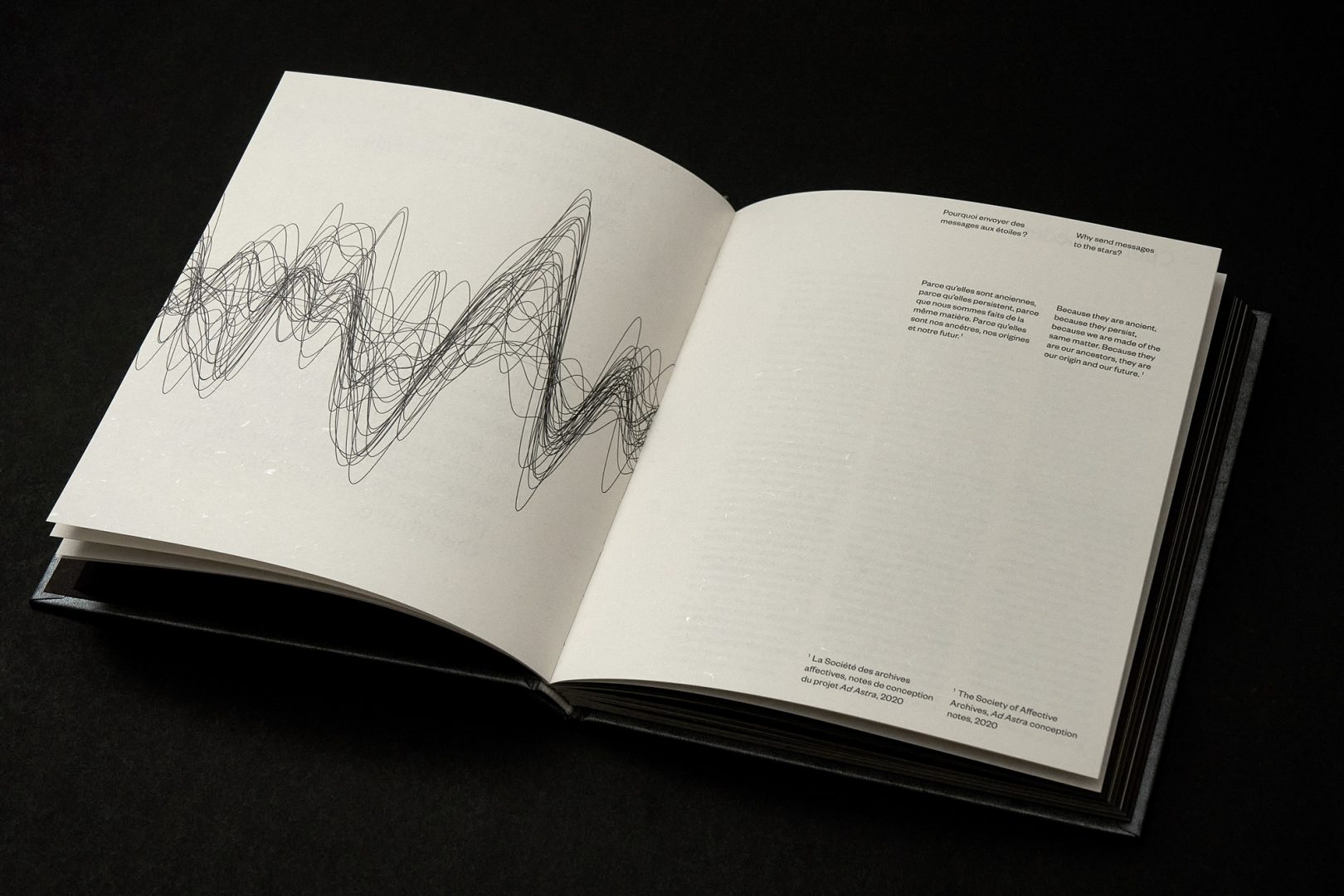
Text and image contribution to the bilingual catalogue 10 ans de Rencontres / Footprints: 10 Years of Rencontres, an epic archive of the annual photography event Rencontres internationales de la photographie en Gaspésie.
Link to catalogue
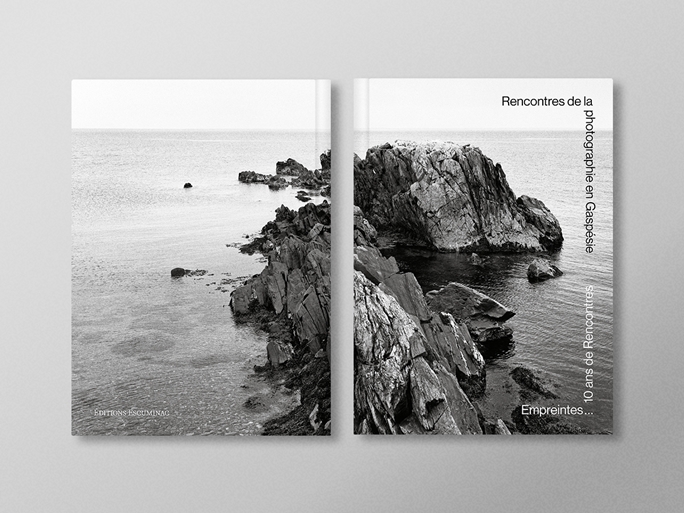
Interview with curator Vicky Chainey Gagnon about the exhibition A Portion of that Which Was Once Everything, presented at the Campbell River Art Gallery.
Read the interview here
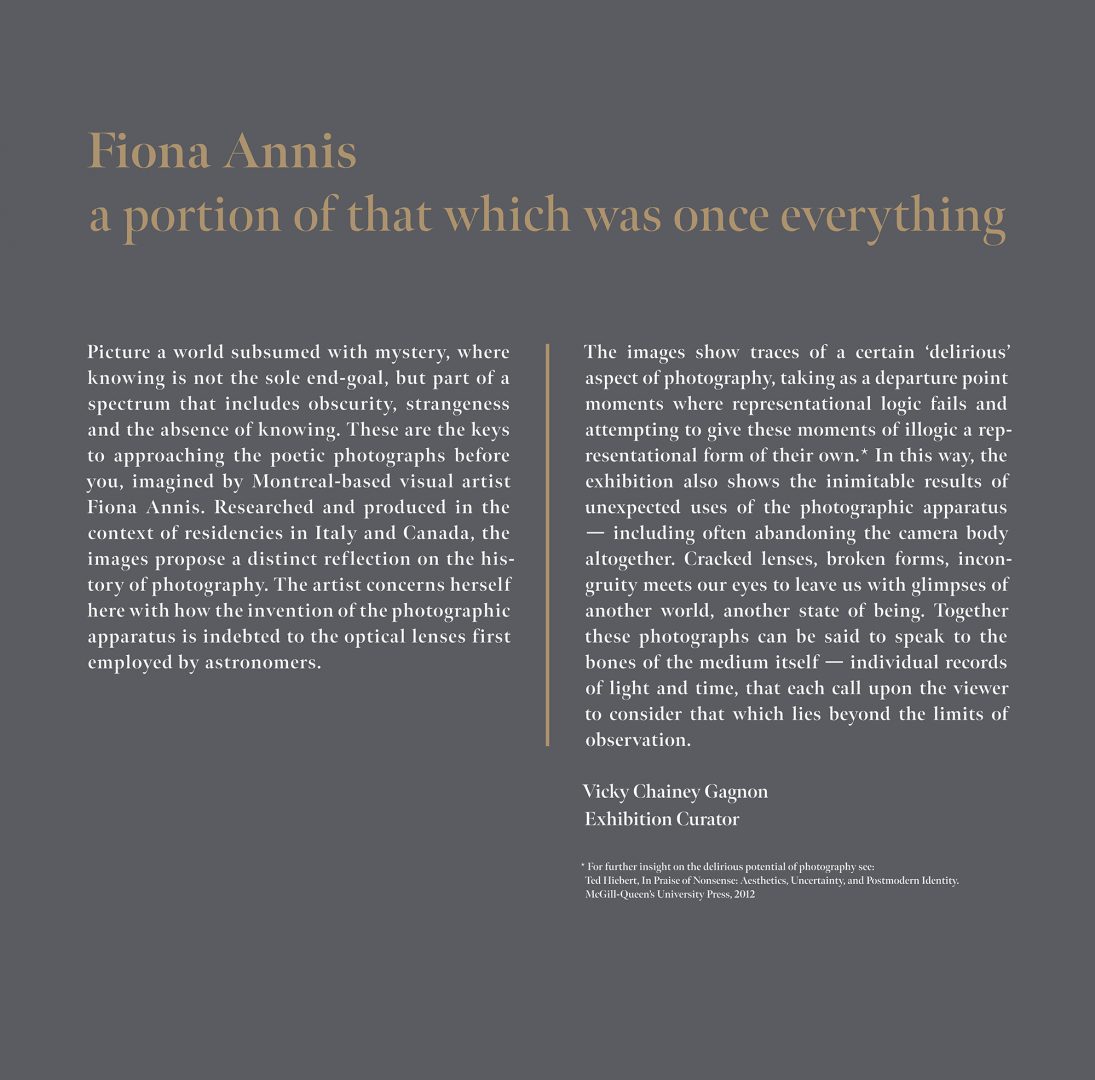
“Like a spell or invocation, lullabies are a set of repeated words and lulling rhythms. Incantations intended to send children to sleep, they are by nature soothing and hypnotic, inducing shifts of consciousness. Across all corners of the world since time immemorial, lullabies have acted as portals into the dream world. Tender, intimate, and coded with folklore, lullabies occasionally recount surprisingly dark stories, embedded within a melodic suggestion of abandon… The origins of this project trace back to San Romano, Italy, where Annis began recording lullabies with various members of the community. For the following two years, the artist continued to record lullabies in Canada and abroad while developing parallel projects. Over time, her collection has grown to include a diversity of voices and languages. Gathered together in this immersive installation, the multiple voices “a thousand times whispered” create a soft murmur, from which the title of the exhibition, Mormorii, takes its name.”
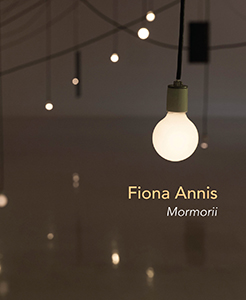
« … l’attention portée par l’artiste aux propriétés physiques du son et de notre propre corps dans l’espace, aura soutenu un passage de l’oralité à l’auralité, de la voix à l’oreille, pour mettre ainsi l’accent sur ce qui est transmis par l’écoute, la répétition et la mémorisation. À activer nos sens de la sorte, et considéré la charge émotive des chants entendus, c’est tout le corps qui se met à vibrer au sein de cette installation, traversé par un doux frisson.»
Link to review

«… bien que Fiona Annis partage avec Kander un point de vue romantique du chaos, elle ne se contente pas d’en sublimer le paradoxe, elle le performe pour en tirer les potentialités créatrices. Située à Maria, l’installation poétique Perdre le nord (2018) rassemble diverses images abstraites qui s’illuminent à la tombée du jour. Des images ont été obtenues par manipulations directes du papier sensible en chambre noire provoquant ainsi des failles à la surface. Comme le suggère Claire Moeder : « Chaque faille évoque une nouvelle lecture du monde, traversée par les processus de destruction et de création ». L’idée d’une destruction créatrice s’exprime aussi par des citations puisées dans L’écriture du désastre de Maurice Blanchot apposées sur d’autres images dont le motif est une constellation formée de diagrammes de la NASA sur le réchauffement climatique. De toute évidence, l’artiste assigne au chaos un potentiel d’activation des possibles et une poétique de la transformation fort inspirante.»
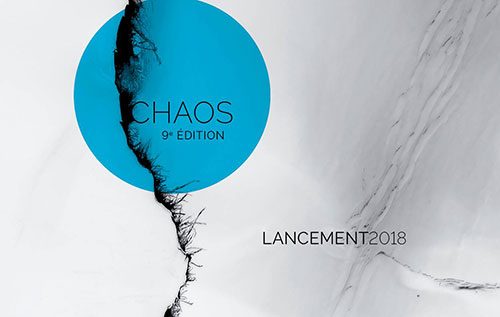
“The new works of artist and photographer Fiona Annis exhibited here offered viewers a truly sublime haunting, an invitation to partake in a séance with the ghost of photography’s past and portents of its future. Employing antiquated photographic processes, primarily the wet-plate collodion technique characterized by hand-processed photographic plates coated with chemistry that Annis mixes herself according to recondite 19th century recipes, she invokes the noumenal and the spectral in her continuing investigation into light and temporality.”
« Avec l’exposition Mormorii, Fiona Annis présente le fruit d’une recherche où l’altérabilité des mémoires et l’idée de marge agissent comme des fils conducteurs, auxquels se mêlent des accents de mystère et de songes. »

“Annis is no mortician of dying stars but their unabashed celebrant, and, in distilling the light of other days, she reminds us of our own mortality. As though through a pane of slow glass, an oculus, she searches for and finds a light worthy of illuminating our own small patch of words, our own acreage of darkness.”
Link to review

« À travers chacun de ses spectres, de ses matérialisations d’images astronomiques, antiques et évanescentes, Fiona Annis offre une existence possible à un récit impossible. Peu importe que l’imagerie soit placée sous le joug d’une catégorie scientifique ou spirite, elle nous soustrait de la véracité optique pour nous ramener dans l’empire des fantômes. Entouré des présences spectrales, glissé le long de la trajectoire d’une comète, notre œil peut dès lors dériver là où la photographie n’entend plus être soumise au témoignage de la réalité matérielle, mais où elle se dérobe pour figurer les invisibles et infiltrer l’imperceptible. »
Link to publication
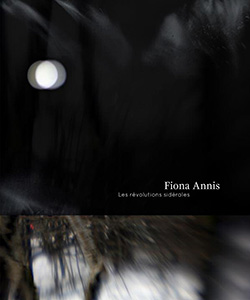
“… Perhaps that is fitting for a show that also takes death as one of its central themes. As the title makes clear, the stars we are seeing and hearing died long ago, their light just arriving to us now. Much like Annis’s previous series, which saw the artist document the locations where intellectuals, novelists and other artists had produced their final works shortly before their untimely deaths, here photography and death are intimately intertwined. If photography freezes time, freezes motion, it does so temporarily. As Annis’s installation demonstrates, time—like light—will continue on without us.”
Link to review
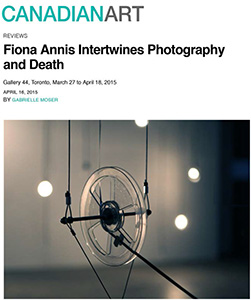
“Annis’s exploration of obsolete photographic techniques informs her work in a variety of media beyond photography, unlocking visual secrets that might otherwise be lost. The stars are dead but their light lives on is a manifestation of Annis’s continued curiosity in the way the past inhabits the present and her interest in remnants that are left behind, only to be rediscovered.”
Link to publication
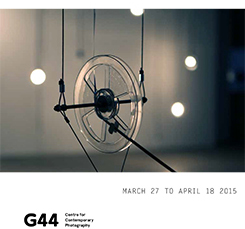
“Presently some theoretical physicists, like Laura Mersini-Houghton, think that our galaxy has a limit, and other scientists have even started to guess at the approximate shape of our universe, or that there is even celestial line that can be drawn where our universe ends.15 It seems that even something as big as the universe may have an end to it. What’s next or left after that? Everything that exists has a beginning, so does everything that exists have an ending? Or perhaps its form simply changes if we believe that matter and even energy changes form rather than disappear… Fiona Annis has found expressive, multifaceted ways of reusing latent technologies to describe these complex ideas about space and what we perceive of our universe, from light bulbs that gently simulate the rhythms of the catastrophes of faraway stars and supernovas, to the use of re ections to show our place in large, dark, mysterious space.”
Link to publication

Colour is a collection of texts and images that record an attempt to think artistically about colour. Tracing a more than two-year conversation between its editors, this volume is a montage of ideas about art and colour slyly mapped against the format of a scholarly review.
PUBLIC 51 includes a series of images by Fiona Annis selected by the contributing editor Aleksandra Kaminska
232 pages, 24 x 19 cm, colour
Graphic Design: Associés Libres
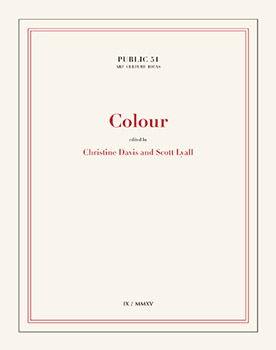
« Fiona Annis présente donc la photographie comme une technique régie par les potentialités du médium meme. Les réactions chimiques, les effets inattendus de la lumière ou de résidus fondent l’esthétique de ses oeuvres. En puisant dans ce langage photographique, l’artiste amène le spectateur dans une temporalité et un espace poétique. Où l’intemporel rencontre le fortuit; et l’intangible, l’instabilité de la matière. »
Link to review
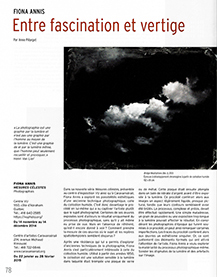
“The gallery is exceptionally dark, lit by faltering constellations of bare bulbs that hang from the ceiling in nebulous clusters. Before your eyes adjust, you perceive an ambient soundscape rolling in from all directions. Remixed “sonic interpretation(s) of dying stars” emanate from vintage reel-to-reel players; orbital loops of magnetic tape arc precariously toward the ceiling. The flickering lights are synced to the radiating signatures of a distant supernova, and they illuminate mirror-like black aluminum panels etched with text from Jeanette Winterson’s 1997 novel Gut Symmetries — fragmentary musings on love and astrophysics.”
Link to review
“Annis’s work is a testament to loss. It extends to our perception the knowledge gained through the contemplation of death, that life itself is the miraculous. Through Annis’s quietude and solace the viewer becomes a witness to the incarnate world.”
Link to review
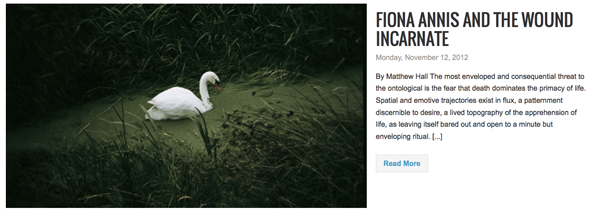
“Unrecognized as a photographer, but not without the experience of several exhibitions and publications, Fiona Annis presents at The McClure Gallery of The Visual Arts Centre, a body of work that may change this situation. The series, The After-Image (SwanSongs), is composed of twelve images and fragments of texts, that has not only the force of a poetic proposition that is sensitive and piercing, but is also executed with a careful and strong mode of contrast that is worthy of the best chiaroscuro work, which gives to the ensemble an aura of mystery that is not uninteresting.
The After-Image (SwanSongs) takes root in documentary photography. In this regard, Fiona Annis registers a variety of places, landscapes, and architectures that are associated with the death of notable artists and intellectuals – at the site of their swan song. These are historical characters, “infamous” or “atypical,” as announced by the artist in the project description.
To “follow” Virginia Woolf, Annis made her way to the River Ouse, where the British writer took her life. She also photographed Canoe Lake in Algonquin Park, the place of the disappearance of the iconic Canadian landscape painter Tom Thomson, as well as the field close to Rome where Pasolini’s body was found not long after the completion of his last film, Salò or the 120 Days of Sodom. In all, eight destinations for eight personalities for which their death, unexpected and/or violent, further contributes to their legend. Amongst these well-known names, we also find a Shannon Jamieson, close to Fiona Annis, who took her life in 2006. The commemorative photo is one of the strongest. It is a sombre composition where we can distinguish, on the steps of a brick building, a makeshift still life, evoking Jamieson’s marginality.
Born in Scotland, and presently established in Montréal where she is pursuing doctoral studies, Fiona Annis delivers across this parcours a series that approaches portraiture. They are ultimate portraits: uncommon and anchored in metaphor rather than description. Driven by the salutary need of creation and thought, these images speak to the tragic deaths of intense lives. Rather than illustrating this intensity by means of extravagant expression, The After-Image swims in sobriety, as though the artist intended to articulate the counterpart of the pendulum. Like poems, the photographs stay open to interpretation.
Swang Song (Ader) presents an expanse of water that is lost at the horizon. This image, for which the plane of gradation takes the viewer toward the light (from beyond?), is in homage to Bas Jan Ader, a conceptual Dutch artist who disappeared off the coast of Ireland in 1976. One single point troubles the careful vantage point, as though a rock disturbed the calm of the water. Many people believe that Ader, like Icarus defying the laws of nature, voluntarily made his drowning his final work.
The ensemble of the exhibited body of work has this force of impact. To evoke Woolf, Annis presents three photos, among them the one that sets the tone of the exhibition: a fine white swan. Also included is Walter Benjamin, the theorist behind the figure of the flâneur, who died in 1940 while trying to escape the Nazi regime. His swan song, the traversal of the Pyrenees that he made on foot, is evoked in the image of this steep wooded path.
On many occasions, Fiona Annis intersperses between these photos succinct texts, evoking parallel knots of thought that link life and death. If her images stand alone, the extracts of text from fetish works of fictional or philosophical literature, insist on death as the suspension of a moment, the fragment of life. Such addresses as « the first great concrete freeing of non-pulsed time» (A Thousand Plateaus, Gilles Deleuze and Félix Guattari) or « we never cease and we never finish to die » (The Space of Literature, Maurice Blanchot) also function as a punctuation between the different sites.
From Gaudi, and a Catalan hospital bathed with rare streams of light, to John Lennon, and also to Mark Lombardi, the selection of epochs and artistic milieus are multiple. And what is most appreciated in the body of work is that, even in the face of a cult-figure such as Lennon, the proposed image is not a fetishism of the site. Here, an anonymous bird’s eye-view of a green lawn brings us back to the pacifist principles of the Beatle and to Central Park, where his ashes were scattered.”
– Translated from French by Véronique La Perrière M.
Link to review
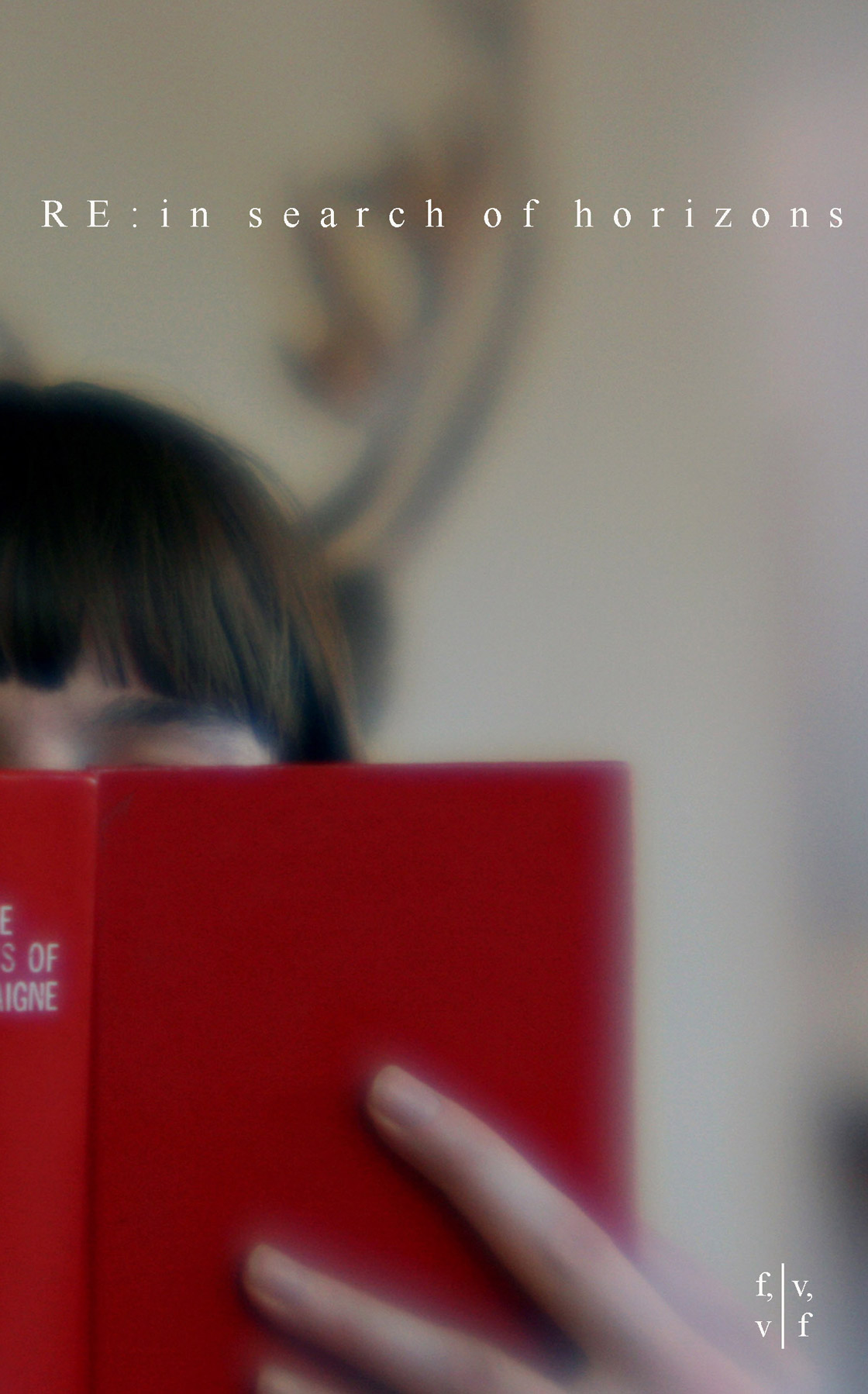
Collaboration with The Society of Affective Archives
Library and Archives Canada: Artists’ Book Collection